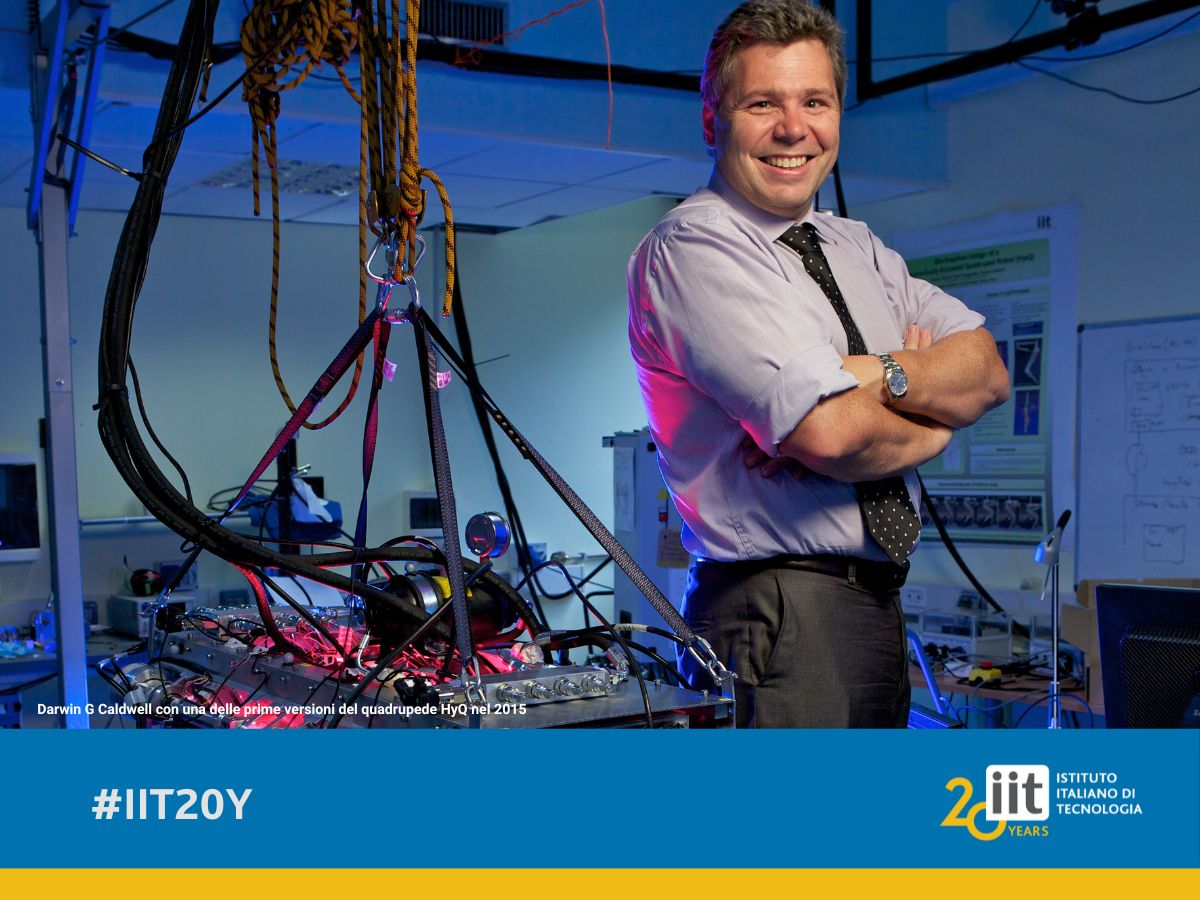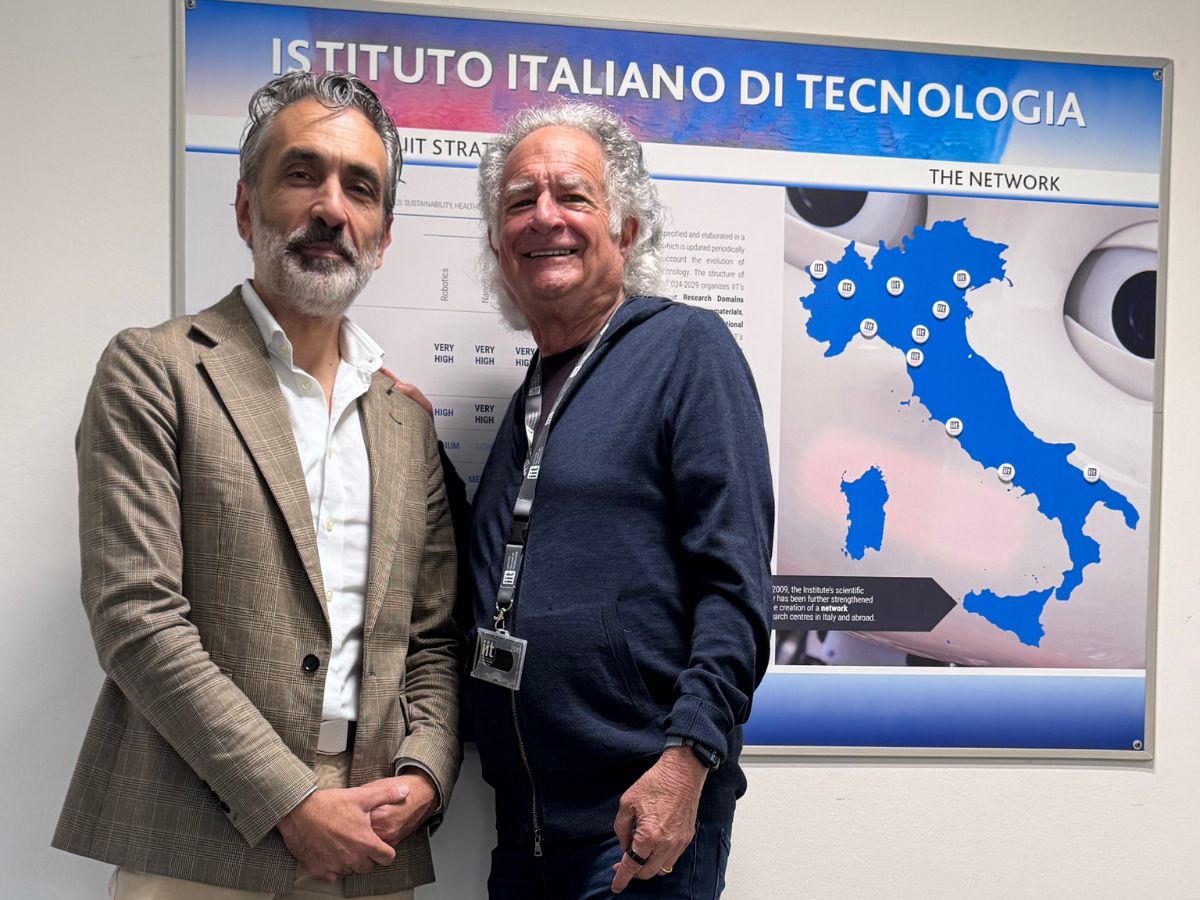Interview with Darwin G Caldwell, Founding Director of the IIT and coordinator of the IIT Advanced Robotics (ADVR) Research Line
You are one of the Founding Directors of IIT, selected through an international call at the very beginning of IIT’s history. IIT existed only as a project when you applied for the position, it was a sort of “blind date” with the future. You were working in the UK. What was the element that convinced you to apply?
Exactly what you have just asked was the same last question that Roberto Cingolani asked me at the interview for the job in 2005. I was about to leave, and Roberto said “Why would somebody from an Anglo Saxon country come to Italy?”, and I actually turned to the panel and said, “Because they would never do anything like IIT in the UK!”, and I don’t think they would do it in most places. I often tell people this, that when IIT was created, it was huge, I think, almost unique in the world. You might say it’s a little bit like a Max Planck Institute or something like this. But in the scheme of things, it was a very, very unique way to do things. What attracted me was the ambition of IIT. What Roberto wanted to create was something truly dynamic on the world stage, something that would have an impact, and essentially an immediate impact. We had to go from nothing to the top of the world. We couldn’t wait 50 or 100 years to achieve this, it had to be achieved in 5 to 10 years. That is the scale, that was the ambition: in a very short space of time going from non-existent to world leading.
The first time you visited the building in via Morego in Genova, what were your first impressions and expectations?
The first thing they had to do was to find the keys. Seriously, we turned up the first day, the building was locked. There was myself, with Jean-Guy Fontaine. This was in May 2006. We were there to sign our contracts and we went up to the building and the building was shut, there was no way around. Collobiano and Cingolani went off to find the keys. We stood there; Jean-Guy went and stood in the shade, and I went and stood in the sun. I remember thinking that’s the difference between a British person and Mediterranean person that he knows it will be sunny tomorrow, and I know tomorrow it will rain! The building was just a shell, just a series of rooms and offices that were used for collecting taxes. We started the planning of how we were going to reshape the space. And there were many things that were suggested, some which were implemented. And many things that were suggested never actually happened. During Christmas time 2006 electricity arrived; in July 2007 desks were assembled in 2 weeks; in September there was the internet. During the first six months every new applicant was interviewed by all the Founding Directors. I attended interviews on subjects that were not mine. In the early days, my recollection is that the ambition was to target a staff of 500 people. The top floor was not even to be used for scientific work, it was supposed to be incubators inside the building. And you can see how it has grown. The growth has been crazy. Today we are probably four, five times what was in the most ambitious scenario. No one expected IIT to be the success it was! Italy didn’t have this reputation for being able to deliver, but IIT delivered! Within five years, everybody was coming to visit, because they all wanted to be part of the success. I think we should be incredibly proud of what was actually achieved in that time. Because I honestly don’t believe anybody, outside Morego expected IIT to happen.
You were part of this growth. Was always a positive feeling?
John Assad said to me once, “Why would I leave in a stable position in the UK, to come to Italy”, and I said, “The ambition of IIT is such that if you can’t make everything successful and create a great career, you have done something wrong. Even if IIT closed after five years, the opportunities in those five years were such that you should be able to do tremendous things which would make your CV great”. That’s what I tell my PhD students, my postdocs. In the period you are here, you will be able to create a CV, that is the envy of any researcher in the world. A lot of the current PIs started off as PhD students, and they worked their way through. Giorgio Metta started off as Giulio Sandini’s PhD student. Nick Tsagarakis was my PhD student before IIT, but he was my PhD student, Claudio Semini was a PhD student, Arash Ajoudani was a PhD student, and there are many, more perhaps especially in robotics. Today these are top researchers in the world. I can’t talk so much for the other areas, but for robotics, if you look at the number of the PIs, who actually came through the system, it’s incredibly high. And I think that’s all down to the training. Lots of institutions can take on very qualified people, but we’ve then been able to use that to build these people. In robotics at IIT, we have one of the highest concentrations of the top researchers in the world. Again, I think we should be incredibly proud of what has been achieved in such a short space of time. I think we’ve done very well.
The Advanced Robotics Department was originally a small lab on a half floor of the current CCT’s building in via Morego that you were leading. Today, 20 years later, that Department has evolved into several research lines, where independent principal investigators conduct their own research studies with their own teams; some of them also have launched start-up companies. Do you remember specific landmark moments or decisions that shaped this growing process?
Genova is not the most attractive city in the world to come to and IIT was a new venture, so getting good people to come to IIT was difficult. The thing you had to do was to attract people inside the building. Once they came into the building and could see what was there, people started to believe. I will give you an example. In 2009 I went in ICRA and IROS, the two big robotics conference; we were 20 people from the Dept. of Advanced Robotics and people at the conferences thought that IIT was the Indian Institute of Technology. Two years later, we went to a similar event; I said I was from IIT and they commented “Oh, you’re from IIT”. And two years after that, we went to a similar event and the people started asking for a job. In the space of three years, we went from not being recognized to people saying, “can we come to IIT?”. That’s how fast we grew and how quickly our reputation came along. I think this was amazing. Each of the new robots we built essentially created a landmark. We had the Coman robot, then the HyQ quadruped, then the Walkman humanoid, then the HyQReal. So, every two years or so, we would produce a new robot. And again, I remember at one of the conferences, I was talking to somebody from the German DLR: one of the leaders in the world. He just looked at me and he said, “How do you build robots so quickly?”. They’re German, they do things in a German way. They’re very efficient, everything’s very professional. IIT just shocked them, that each robot got better and better and better. For me it was a sign that we had arrived on the world stage. I use DLR quite often as a benchmark. They were the best in the world. I remember having a conversation with another person from DLR and he told me “Yeah, you passed us a couple of years ago”. Maybe he was being nice to me, but I like to think that we are in the same league with the very best. And I’m very happy that that’s true.
How important has “technology transfer” been?
Robotics is an engineering discipline and engineering is about making things that people want. Therefore, technology transfer is an essential part of any type of engineering discipline. As a researcher you get your papers, you win prizes, you get international respect, but there is something special about producing things that make a difference. The growth in robotics has been astounding. When I first got my job as a lecturer, many years ago, I probably got the only job in the UK for five, seven years. Now there are 50 jobs advertised every day. In robotics the opportunities are immense. The job opportunities, the career opportunities, the potential grows, and the applications grow every day. So, anybody who comes to IIT, what they are really doing is putting down this massive foundation, which they can use to springboard their career. And that’s the key thing for the young guys, IIT is this massive springboard for the future, whether that’s into an academic career, or into an industrial career and that can be inside large companies but also, they have the opportunities to do this themselves. A reasonable number of our guys have gone away and created their own startups. IIT is still learning what technology transfer is; we know what good science is, now we are learning what good technology transfer is. To enter the technology transfer you need to get the technology to a certain level. After 10 years I created in my Department, the Industrial Robotics labs., which are different because they do not have to produce papers, but rather they have to solve problems with and for companies, and have joint-labs with them. Industrial labs are happy to deliver results to the companies.
What do you think could be – after 20 years of experience – the legacy that IIT, and the younger generations, should consider for the future?
IIT has had a great start. It has developed into one of the leading institutions in the world. We are now more in line with how international research centers operate. What we have to do is to keep working together. The big advantage of the original big departments was the ability to create big projects, this was intrinsically across domains. You could do massive projects because you could bring together different people. What was not possible was to cooperate easily with other groups, such as roboticists with neuroscientists or new materials. Team building is key for the future. A team is better than a series of individuals. Once I had a professor visiting IIT. He was originally hostile to IIT, as many were in the early days, but after 5 years he came to visit and was very positive. I remember that he stepped into the lift, and he stopped, he stepped back out of the lift and said “This is great, this is wonderful. IIT is American with Italian flair”. IIT was a happy place, it was not only a place where people worked, but where people built friendships. This was part of the strength that built IIT so quickly.





